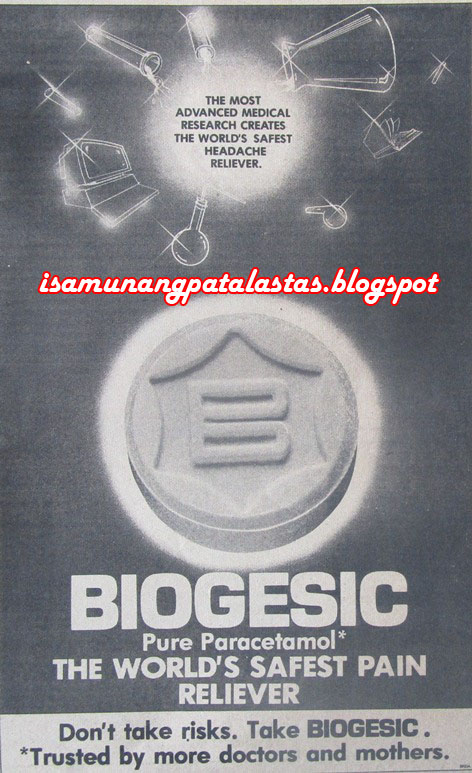(This article originally appeared in the online magazine Esquire Philippines www.esquiremag.ph, on 11 Feb. 2019, under the title "Funniest Filipino Brand names in the 20th Century", commissioned from the author, Alex del Rosario-Castro)
What’s in a brand
name? A brand name defines and differentiates a product from its competitors in
the eyes of the customer. So important are brand names that they can make or
break a product—an urban legend has it that a car maker once named its new
vehicle “Nova”, not knowing that “no va” meant “not going” in Spanish.
Would you go to a
coffee house called “Cargo House” or “Pequod”? Those names by the way, were
considered for your now favorite Starbucks. Then, there’s Lithiated Lemon, a lemon-lime
drink introduced in 1929. But when renamed 7-Up, sales increased six-fold. On
the other hand, there are perfect brand names like “Jollibee”, “Hapee” and
“Mr.Clean” that evoke positive images of joy, clean living and fun.
Before marketing
experts offered their brand-naming services, many makers of products just
coined their own brand names, resulting in amusing, unusual and sometimes,
weird-sounding names.
***********
ANALGINA: Brand Name for a Medicine Syrup for rheumatism and headaches.ANALGINA is the name of this cure-all also indicated for
diarrhea, neuralgia, cramp, breastache, backache, indigestion and cough. At
first impression, it has a name seemingly coined from two delicate parts of the
human female anatomy—well, at least that’s how it reads. But the first part of the brand name is
derived from ‘analgesia” , which means “relief from pain”. With the suffix added however, ANALGINA, as a brand
name, doesn’t evoke anything medicine-y; rather it sounds like a disease! In 1929, you can buy ANALGINA over-the-
counter at Botica Insular along Quesada St. in Manila. Just don’t say the name
out loud.
ASEMBLEA FILIPINA: Brand Name for : Local
cigarettes
Why would someone name a cigarette brand after the
Philippine Assembly (ASEMBLEA FILIPINA) ?
Well, Simeon Roque y Compania, maker of
these “cigarillos” in Betis,
Pampanga, just did. In fairness, the inauguration of the Philippine Assembly in
1907 was a major event, as that gave a glimmer of hope to Filipinos for
self-rule. To the local cigarette maker maybe, that historic milestone is worth
celebrating with a puff of a “cigarillo”
stick. The cigarette label of “ASEMBLEA FILIPINA” cigarettes even contain a short poem in the vernacular, exhorting
customers Philippine-made products, not imported ones—and exhortation to
nationalism, at a time we needed it most.
ATOMIC / ATOMI-CHLOR: Brand Name for
: Pomade / Pesticide
The atomic age began when the first nuclear bomb was
detonated in 1945 that led to the bombing of Hiroshima and Nagasaki which ended World War II. It also started our
fascination with atomic designs and organic forms, inspired by atoms, missiles and rockets, that
found their way in product designs and even in brand names. Such is the case
with two different products sold and manufactured locally in the 50s .The first
is ATOMIC Solid Brilliantine, a
men’s pomade brand available in
glass jars. What can this pomade do? Will it split the atoms in your hair? Will you be positively charged? We may never
know as this product had a short shelf life.

Another is ATOMI-CHLOR,
a liquid product formulated to rid pet dogs and your lawn of fleas, ticks and insects. This
Chlordane-based product came out in 1951. One is wont to wonder if ATOMI-CHLOR had radioactive properties
that killed these pests. But we now know that Chlordane is a chemical compound classified
as an organic pollutants hazardous to animals, and even human health. Oops.
BAGONG LITAO: Brand Name for Local
cigarettes
Another strange name for a cigarette brand is “BAGONG
LITAO” (Newly-Appeared), locally made and rolled in Pampanga by a certain
Martin Torres. Even the front panel illustration is rather odd: it shows 3
Filipina women in baro’t saya—and
they are not even smoking. For cure,
BAGONG LITAO is a reference to the new arrival of the product. But wouldn’t the
name become obsolete in a year or so? Because by then, it will no longer be
new. It will no longer be BAGONG LITAO, right? Hmmm, I need a smoke.
BALATKINIS: Brand Name for a Skin
Ointment
Katialis is the most successful and most popular local
skin ointment in history, with a formula developed by Dr. Lorenzo C. Reyes. Its
name was derived from Kati+ Alis (Itch Away) . But the actual concoction was
done by his chemist brother, Manuel, who mixed the ointment at the Locre
Laboratorio in San Lazaro, Manila. After a decade, Manuel struck it on his own
and developed his own product in that,
like Katialis, promised to eradicate: “galis,
buni, pigsa, tagihawa, butlig, anan,pekas alipunga at sugat na maliliit”. Manuel also named it like Katialis—combining Balat
+ Kinis to come up with the brand name BALATKINIS (Smooth Skin). Launched in 1947, BALATKINIS, the copycat
product with a copycat name proved to be short-lived.


















